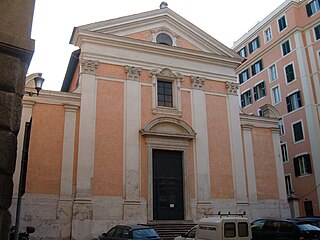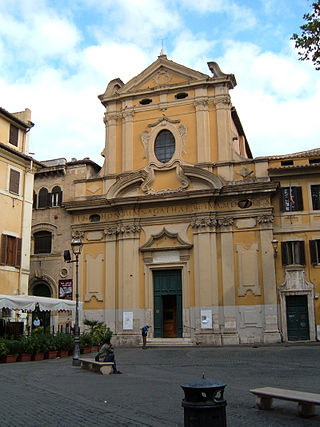
The Palazzo Muti is a large townhouse in the Piazza dei Santi Apostoli, Rome, Italy, built in 1644. Together with the neighboring Palazzo Muti Papazzurri, it originally formed part of a complex of adjoining palazzi and other houses owned by the Muti Papazzurri family. During the 18th century this entire range of buildings was, by courtesy of the pope, the residence of the Stuart dynasty while in exile in Rome. They were recognised by the Catholic Church as the rightful kings of Great Britain and Ireland. The Palazzo Muti should not be confused with the Palazzo Muti Papazzurri in the Piazza della Pilotta which was designed by Mattia de' Rossi in 1660.

Santo Stefano de Pinea or more commonly Santo Stefano del Cacco is a church in Rome dedicated to Saint Stephen, located at Via di Santo Stefano del Cacco 26.

Santi Vincenzo e Anastasio a Trevi is a Baroque church in Rome, the capital of Italy. Built from 1646 to 1650 to the design of architect Martino Longhi the Younger and located in close proximity to the Trevi Fountain and the Quirinal Palace, for which it served as parish church, it is notable as the place where the precordia and embalmed hearts of 22 popes from Sixtus V to Leo XIII are preserved.

Santa Maria della Quercia is a Roman Catholic church located on the piazza of the same name, one block southeast of the Palazzo Farnese in the Rione (district) of Regola of central Rome, Italy.

San Giovanni Calibita is a Roman Catholic church located in the rione of Ripa on the Isola Tiberina, next to the Fatebenefratelli Hospital.

The Chiesa di Santa Rita da Cascia in Campitelli is a deconsecrated church in Rome (Italy), in the rione Sant'Angelo; it is located in Via Montanara, at the crossroad with Via del Teatro Marcello. The church formerly rose on the preexisting church of San Biagio de Mercato, dating at least to the 11th-century. The remains of St Blaise putatively were discovered during the dismantling of Santa Rita.

San Pantaleo is an ancient church located on a piazza of the same name along Corso Vittorio Emanuele II in the Parione neighborhood of Rome, Italy. It shares the Piazza with the Museo di Roma in Palazzo Braschi. A church at the site dates from the 12th-century, but the present facade (1807) is in a Neoclassical style and the interiors were elaborated in a Baroque style.

Santa Rita da Cascia alle Vergini is a Roman Catholic church in Rome, sited at the corner of Via delle Vergini and Via dell’Umiltà. Diagonal from the church on Via delle Vergini is the Teatro Quirino.

Santa Caterina da Siena is a church in Rome dedicated to Catherine of Siena. It is sited on via Giulia in the Regola district.

Santa Croce e San Bonaventura alla Pilotta or Santa Croce e di San Bonaventura dei Lucchesi is a church in Rome, sited on via dei Lucchesi in the Trevi district, between the Trevi Fountain and the Pontificia Università Gregoriana. It is Lucca's regional church in Rome.

Santa Maria della Concezione is a church in Rome, located on Piazza Campo Marzio in the Campo Marzio rione. It serves as the national church in Rome for Syriac Catholics.

San Basilio agli Orti Sallustiani is a rectory church in Rome, on via Trevi in the Trevi district. It is dedicated to Saint Basil. The church is a secondary place of worship for the Parish of San Camillo de Lellis.

Santo Stanislao dei Polacchi, also known as San Stanislao alle Botteghe Oscure, is a Roman Catholic church in Rome, sited on Via delle Botteghe Oscure in the Sant'Angelo rione. It is the national church of Poland in Rome.

Santissima Trinità a Via Condotti or Santissima Trinità degli Spagnoli is a church in Rome at the start of via Condotti in the Campo Marzio district. It is one of the national churches of Spain in Rome.

Natività di Gesù is a church on Piazza Pasquino in the Parione rione of Rome. It is the national church in Rome of the Democratic Republic of Congo.

Santa Barbara dei Librai is a small Roman Catholic church in Rome, Italy. It was once known as Santa Barbara alla Regola after the rione in which it was located. Today it now considered within the rione of Parione, near the Campo de' Fiori.

Santa Maria in Monterone is a Roman Catholic church in Rome, Italy. Its suffix originates from the Sienese Monteroni family, whose patronage rebuilt the church and built a small hospice next to it for pilgrims from Siena. It is located on Via Santa Maria in Monterone in the Sant'Eustachio rione. Next to the church is a Redemptorist monastery, whose clergy manage the church.

Sant'Agata in Trastevere is one of the churches of Rome, located in the Trastevere district, at Largo San Giovanni de Matha, 91.

Santa Maria Portae Paradisi is a catholic church in Rome, in the Rione Campo Marzio, along via di Ripetta.

The church of Santa Galla was a church in Rome (Italy), in the Rione Ripa, on the road that connected Piazza Montanara with Piazza della Bocca della Verità. Both the church and the square in front of it were destroyed between 1928 and 1930 for the construction of the first stretch of Via del Mare ; the furnishings and the altar were relocated to the new church of Santa Galla at Garbatella, built in 1940.






















